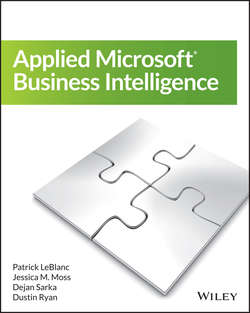Applied Microsoft Business Intelligence

Реклама. ООО «ЛитРес», ИНН: 7719571260.
Оглавление
Sarka Dejan. Applied Microsoft Business Intelligence
Introduction
Overview of the Book and Technology
How This Book Is Organized
Who Should Read This Book
Tools You Will Need
What's on the Website
Summary
Part I. Overview of the Microsoft Business Intelligence Toolset
Chapter 1. Which Analysis and Reporting Tools Do You Need?
Selecting a SQL Server Database Engine
Selecting SQL Server Analysis Services
Working with SQL Server Reporting Services
Working with SharePoint
Working with Performance Point
Using Excel for Business Intelligence
Which Development Tools Do You Need?
Summary
Chapter 2. Designing an Effective Business Intelligence Architecture
Identifying the Audience and Goal of the Business Intelligence Solution
What Are the Data Sources?
Using a Data Warehouse (or Not)
Implementing and Enforcing Data Governance
Planning an Analytical Model
Planning the Business Intelligence Delivery Solution
Considering Performance
Considering Availability
Summary
Chapter 3. Selecting the Data Architecture that Fits Your Organization
Why Is Data Architecture Selection Important?
How Do You Pick the Right Data Architecture?
Summary
Part II. Business Intelligence for Analysis
Chapter 4. Searching and Combining Data with Power Query
Downloading and Installing Power Query
Transforming Data
Introducing M Programming
Summary
Chapter 5. Choosing the Right Business Intelligence Semantic Model
Understanding the Business Intelligence Semantic Model Architecture
Understanding the Data Access Layer
Implementing Query Languages and the Business Logic Layer
Comparing the Different Types of Models
Which Model Fits Your Organization?
Summary
Chapter 6. Discovering and Analyzing Data with Power Pivot
Understanding Hardware and Software Requirements
Enabling Power Pivot
Designing an Optimal Power Pivot Model
Optimizing the Power Pivot Model for Reporting
Summary
Chapter 7. Developing a Flexible and Scalable Tabular Model
Why Use a Tabular Model?
How Do You Design the Model?
How Do You Enhance the Model?
How Do You Tune the Model?
Summary
Chapter 8. Developing a Flexible and Scalable Multidimensional Model
Why Use a Multidimensional Model?
How Do You Design the Model?
How Do You Enhance the Model?
How Do You Tune the Model?
Summary
Chapter 9. Discovering Knowledge with Data Mining
Understanding the Business Value of Data Mining
Getting the Basics Right
Applying the Microsoft Data Mining Techniques with Best Practices
Developing and Deploying a Scalable and Extensible Data Mining Solution
Maintaining Data Mining Models
Integrating Data Mining with Your BI Solution
Summary
Part III. Business Intelligence for Reporting
Chapter 10. Choosing the Right Business Intelligence Visualization Tool
Why Do You Need to Choose?
What Are the Selection Criteria?
How Do You Gather the Necessary Information?
What Are the Business Intelligence Visualization Options?
How Do You Create and Complete the Evaluation Matrix?
How Do You Verify and Complete the Process?
Summary
Chapter 11. Designing Operational Reports with Reporting Services
What Are Operational Reports and Reporting Services?
What Are Development Best Practices?
What Are Performance Best Practices?
What Are Functionality Best Practices?
Summary
Chapter 12. Visualizing Your Data Interactively with Power View
Where Does Power View Fit with Your Reporting Solution?
Power View System Requirements
Creating Power View Data Source Connections
Creating Power View Reports
Filtering Data with Power View
Exporting Power View Reports
Summary
Chapter 13. Exploring Geographic and Temporal Data with Power Map
How Power Map Fits into Reporting Solutions
Optimizing Your Data Model for Power Map
Working with Geospatial and Temporal Data
Deploying and Sharing Power Map Visualizations
Summary
Chapter 14. Monitoring Your Business with PerformancePoint Services
Where Does PerformancePoint Services Fit with Your Reporting Solution?
Extending PPS Dashboards
Deployment Best Practices
Security and Configuration Best Practices
Summary
Part IV. Deploying and Managing the Business Intelligence Solution
Chapter 15. Implementing a Self-Service Delivery Framework
Planning a Self-Service Delivery Framework
Inventorying Tools and Skillset
Defining Success Criteria
Summary
Chapter 16. Designing and Implementing a Deployment Plan
What Is a Deployment Plan?
How Do You Deploy Business Intelligence Code?
How Do You Implement the Deployment Plan?
Summary
Chapter 17. Managing and Maintaining the Business Intelligence Environment
Using SQL Server Reporting Services
Configuring Memory
Working with SQL Server Analysis Services
Using SharePoint to Improve Performance
Summary
Chapter 18. Scaling the Business Intelligence Environment
Why Would You Scale the Business Intelligence Environment?
How Do You Scale Each Tool?
Summary
Credits
About the Authors
About the Technical Editor
Acknowledgments
WILEY END USER LICENSE AGREEMENT
Отрывок из книги
Business intelligence, including reporting and analytics, is essential to an organization's survival and growth. Understanding your data and turning it into actionable insights is the key to sustaining and growing your business. As companies recognize this need, the employees that facilitate these insights, also known as “data scientists,” are highly sought after across the board.
Microsoft's business intelligence suite contains tools that help the data scientists and developers perform their duties quickly and efficiently. Understanding which tool to use and how to use it in the best manner is required to provide the data. This book discusses each of the business intelligence tools and best practices associated with the Microsoft business intelligence stack, including reporting and analysis.
.....
In SharePoint, you can develop custom pages that consume other technologies. Figure 1.7 integrates four different technologies into a single view. The resulting web page centralizes four distinct views of data spanning features that are made available by different software vendors. In addition to customized pages, business intelligence developers can leverage Performance Point, a dashboarding feature of SharePoint. The details of Performance Point are discussed in the next section.
While SharePoint does offer this extended capability of integrating disparate technologies, the Microsoft business intelligence stack does provide a sufficient number of tools and features for deploying a holistic business intelligence solution. Therefore, if an organization is evaluating vendor solutions, leveraging SharePoint typically addresses all the business intelligence needs for a given project.
.....